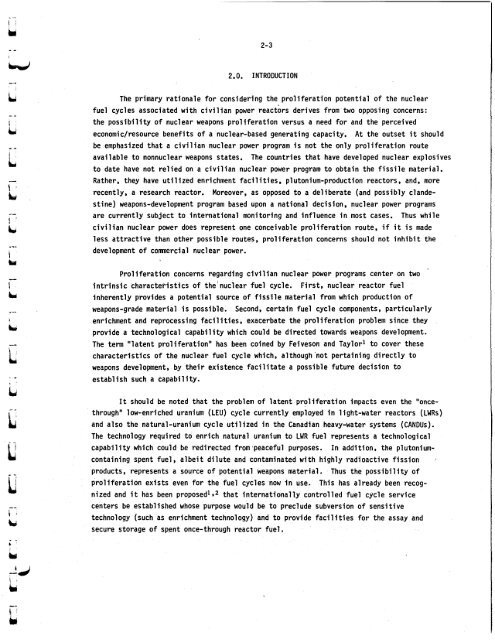ORNL-5388 - the Molten Salt Energy Technologies Web Site
ORNL-5388 - the Molten Salt Energy Technologies Web Site
ORNL-5388 - the Molten Salt Energy Technologies Web Site
Create successful ePaper yourself
Turn your PDF publications into a flip-book with our unique Google optimized e-Paper software.
huJ<br />
--<br />
AI<br />
I '<br />
b<br />
---<br />
I<br />
bl<br />
---<br />
t<br />
L<br />
L<br />
.-<br />
id<br />
--<br />
I '<br />
b<br />
2-3<br />
2.0. INTRODUCTION<br />
The primary rationale for considering <strong>the</strong> pro1 iferation potential of <strong>the</strong> nuclear<br />
fuel cycles associated with civilian power reactors derives from two opposing concerns:<br />
<strong>the</strong> possibility of nuclear weapons proliferation versus a need for and <strong>the</strong> perceived<br />
economic/resource benefits of a nuclear-based generating capacity. At <strong>the</strong> outset it should<br />
be emphasized that a civilian nuclear power program is not <strong>the</strong> only proliferation route<br />
available to nonnuclear weapons states. The countries that have developed nuclear explosives<br />
to date have not relied on a civilian nuclear power program to obtain <strong>the</strong> fissile material.<br />
Ra<strong>the</strong>r, <strong>the</strong>y have utilized enrichment facilities, plutonium-production reactors, and, more<br />
recently, a research reactor. Moreover, as opposed to a deliberate (and possibly clande-<br />
stine) weapons-development program based upon a national decision, nuclear power programs<br />
are currently subject to international monitoring and influence in most cases. Thus while<br />
civilian nuclear power does represent one conceivable proliferation route, if it is made<br />
less attractive than o<strong>the</strong>r possible routes, proliferation concerns should not inhibit <strong>the</strong><br />
development of comnercial nuclear power.<br />
Pro1 iferation concerns regarding civi 1 ian nuclear power programs center on two<br />
intrinsic characteristics of <strong>the</strong>'nuclear fuel cycle.<br />
inherently provides a potential source of fissile material from which production of<br />
weapons-grade material is possible.<br />
enrichment and reprocessing facilities, exacerbate <strong>the</strong> proliferation problem since <strong>the</strong>y<br />
provide a technological capability which could be directed towards weapons development.<br />
The term "latent proliferation' has been coined by Feiveson and Taylor' to cover <strong>the</strong>se<br />
characteristics of <strong>the</strong> nuclear fuel cycle which, although 'not pertaining directly to<br />
weapons development, by <strong>the</strong>ir existence facilitate a possible future decision to<br />
establish such a capability.<br />
First, nuclear reactor fuel<br />
Second, certain fuel cycle components, particularly<br />
It should be noted that <strong>the</strong> problem of latent proliferation impacts even <strong>the</strong> "once-<br />
through" low-enriched uranium (LEU) cycle currently employed in 1 ight-water reactors (LWRS)<br />
and also <strong>the</strong> natural-uranium cycle utilized in <strong>the</strong> Canadian heavy-water systems (CANDUs).<br />
The technology required to enrich natural uranium to LWR fuel represents a technological<br />
capability which could be redirected from.peacefu1 purposes. In addition, <strong>the</strong> plutonium-<br />
containing spent fuel, albeit dilute and contaminated with highly radioactive fission .<br />
products, represents a source of potential weapons material. Thus <strong>the</strong> possibility of<br />
proliferation exists even for <strong>the</strong> fuel cycles now in use. This has already been recog-<br />
nized and it has been proposed1n2 that internationally controlled fuel cycle service<br />
centers be established whose purpose would be to preclude subversion of sensitive<br />
technology (such as enrichment technology) and to provide facilities for <strong>the</strong> assay and<br />
secure storage of spent once-through reactor fuel.



![Review of Molten Salt Reactor Physics Calculations [Disc 2]](https://img.yumpu.com/21979492/1/190x247/review-of-molten-salt-reactor-physics-calculations-disc-2.jpg?quality=85)












